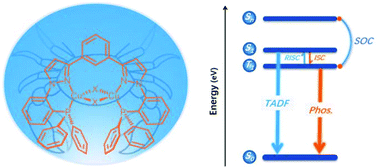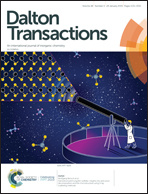Highly luminescent copper(i) halide complexes chelated with a tetradentate ligand (PNNP): synthesis, structure, photophysical properties and theoretical studies†
Abstract
Two emissive copper(I) halide complexes (PNNP)Cu2Br2 (1) and (PNNP)Cu2I2 (2), which are constructed from butterfly-shaped dinuclear Cu2X2 cores and a new tetradentate ligand (PNNP = 1,3-bis(1-(2-(diphenylphosphanyl)phenyl)-1H-pyrazol-3-yl)benzene), were synthesized and characterized. These chelates exhibit bright green (λmax = 517 nm, 1) and bluish-green (λmax = 492 nm, 2) photoluminescence in the solid state with quantum yields of 42% (1) and 58% (2), and lifetimes of 13 μs (1) and 8.8 μs (2) at room temperature. Computational density functional theory/time-dependent density functional theory (DFT/TDDFT) calculations were performed to elucidate the nature of their electronic transitions and to predict their detailed photophysical properties. The results of DFT/TDDFT calculations, combined with the temperature dependence of spectroscopic properties and emission decay behaviors, suggest that the emission in the solid state originates from the 1,3(MLCT + XLCT + ILCT) excited states, which are in thermal equilibrium with small energy differences of about 0.1 eV. A comparative study of the titled complexes reveals that the emissive-state characteristics and photophysical properties of these complexes are significantly affected by the ligand field strength and atomic number of the halogen atom, as well as by the percentage of the XLCT transition involved in the lowest excited states. Compared with its bromide counterpart (1), the iodide complex (2) shows a much higher phosphorescence quantum yield (0.94 vs. 0.50), a much shorter phosphorescence decay time (58 μs vs. 274 μs), a much larger phosphorescence rate constant (1.6 × 104 s−1vs. 1.8 × 103 s−1), and a larger phosphorescence contribution (25% vs. 8%) in room-temperature emission, due to the more efficient spin–orbit coupling (SOC).



 Please wait while we load your content...
Please wait while we load your content...